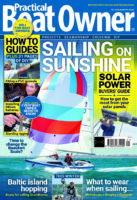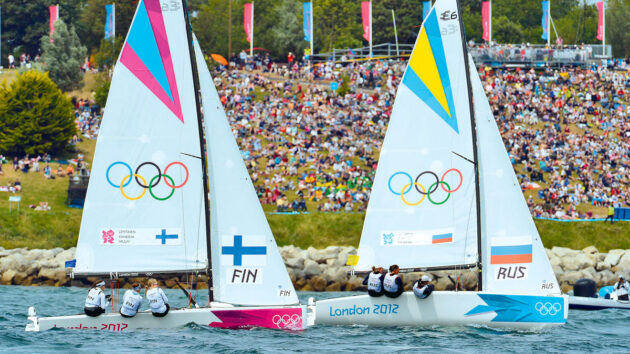In its 150th year, Laura Hodgetts explores the Royal Yachting Association’s evolution over a century-and-a-half from ‘gentlemen racers’ to a world-leading national boating body
The Royal Yachting Association was originally launched into a gentlemen-only sailing club era, when Britain’s dinghy scene had barely started and yachts were becoming subject to local-specific rules.
Initially called the Yacht Racing Association (YRA), it was founded in November 1875.
Aside from the Royal Victoria Yacht Club – set up on the Isle of Wight in 1845 so that the Queen could be a member – most establishments were ‘male only’.
The YRA met a need for an umbrella organisation that would unify the rules covering handicaps of boats depending on their tonnage, and for behaviour afloat.
The association began with just over 120 members, each paying two guineas (equivalent to about £320 today). Despite much support, the detractors were out in force, decrying the efforts to control what was seen as a free sport.
However, in 1881, when the Royal Thames Yacht Club and Royal Yacht Squadron became affiliated, it gave the association a greater mandate to put the sport on a sounder footing.
Early responsibilities
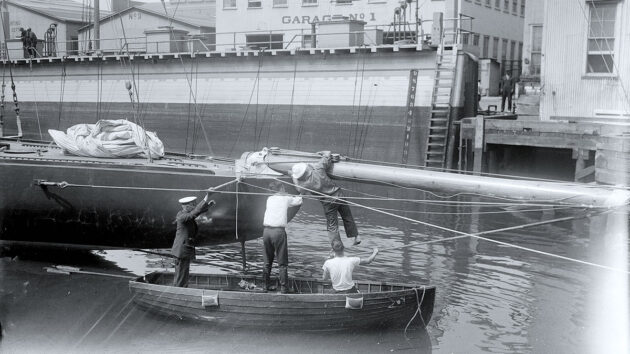
Sir Thomas Lipton’s Shamrock IV being measured in preparation for the 1920 America’s Cup. Credit: Heritage Image Partnership Ltd/Alamy
A unified set of rules was published at a shilling (5p) a copy and adopted for British waters. The YRA revised the rating rules, which were thought to overly-penalise beam.
However, the YRA’s so-called ‘1730’ rule drove the ‘planks on edge’ trend, with extreme boats built with an overall length of 40ft-plus but a beam of under six feet – narrower than a Wayfarer dinghy today.
These excessively narrow boats had little value away from the racecourse, and there was concern that it was hampering the yachting scene.
So the YRA tasked yacht designer Dixon Kemp to devise more meaningful rating rules which, published in 1886, helped to reset the philosophy with ‘owner-friendly’ designs.
Testing times
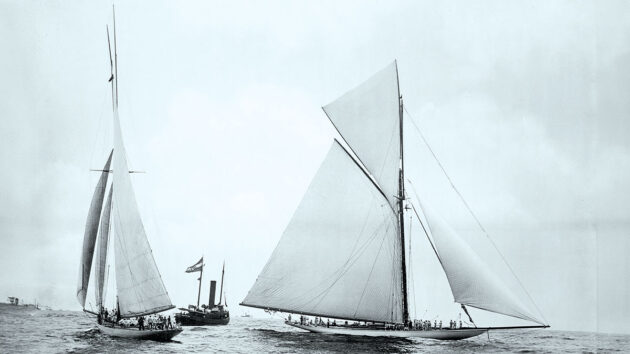
1894 tested the YRA’s final arbiter role. Credit: Heritage Image Partnership Ltd/Alamy
The YRA’s role as a final arbiter of protests arising from boat-on-boat and rating-related incidents was tested in 1894 when, during a race on the Clyde, Lord Dunraven’s America’s Cup yacht Valkyrie II was T-boned by the American yacht, Satanita. Valkyrie II sank, and a crew died.
Under the ‘Board of Trade’ rule of the time, Satanita’s owner was only liable for damages, which awarded Dunraven eight shillings (40p!) per rated ton.
Dunraven sued for the whole value, with the case going from the YRA to the High Court, and the House of Lords, where it was upheld that when an owner entered a race, he undertook a contractual obligation to make good any damage.
Another foundation of the YRA’s rules had been confirmed, and the development of yacht insurance was instigated.
Another hot topic in the late 1890s was the management of the budding dinghy racing scene. Members were in clear agreement: the association represented yachts, for ‘gentlemen sailors’, and had no place for small boats.
The arrival of lightweight racing yachts from overseas led to the YRA’s scantling UK rule being adopted internationally.
Another big change came in 1904, when the YRA allowed women to join.
Its first female member, Mrs HG Allan, based in the Solent, was an accomplished sailor. However, it wasn’t until 1912 that women could be full racing members, rather than ‘associate’ members for decoration or weight.
In 1905, when other nations needed a joint rating rule, the YRA took the lead.
The importance of the association’s role in international yachting was also highlighted in 1908 when London hosted the fourth ‘new’ Olympic Games.
When the Games were introduced at Athens in 1894, it was envisaged that the 6, 7 and 8 Metre sailing classes would race off Ryde, Isle of Wight, while the 12 Metre class would be held on the Clyde, Scotland. There was a powerboat event too.
The YRA held responsibility for the event but there was now enough support to allow for an Olympic sub-committee.
Small boat ban
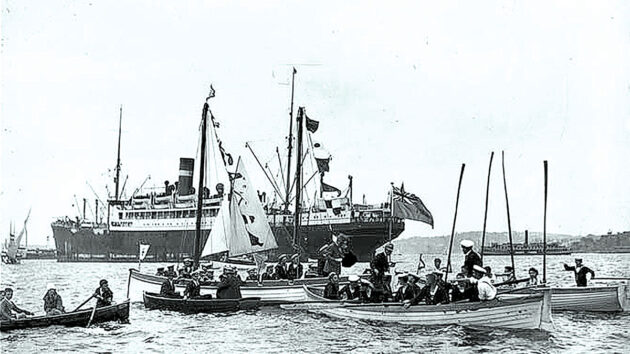
Dinghies and the Boat Racing Association were not part of the YRA until 1921. Credit: History collection 2016/Alamy
The subject of getting younger people into the sport was being increasingly discussed by the YRA, but the door was still closed to dinghies.
Small boat sailing was still being organised by the Boat Racing Association (BRA) which in 1912 selected a new single-handed dinghy.
The winning boat, BRA-1 would go on to become the International 12.
But the YRA held out against unifying dinghies and yachts under one management structure.
In 1914, things began to move in the right direction, only for World War I to bring about a four-year hiatus.
After hostilities ended in late 1918, getting yachting restarted was problematic, with submarine barriers and, worse, minefields not cleared.
Still, in early 1919, the YRA hosted the ‘largest gathering of yachtsmen’ where new ground rules were laid for future competition.
In 1921, an agreement welcomed BRA into the YRA, which meant dinghies would be represented on home waters and also internationally.
In 1925, the Royal Victoria Yacht Club launched The Ocean Race – later to be the Fastnet Race – from the Solent, across the Irish Sea to the Fastnet Rock, and back to Plymouth.
The YRA was now responsible for all things boating, from the fledgling dinghy scene to a UK-hosted offshore race.
In the late 1920s, the YRA racing rules were adapted to apply to all craft, and it began printing its own Rule Books.
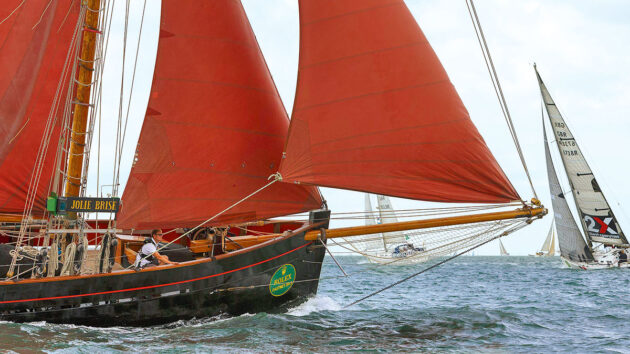
The Ocean Race was the YRA’s first offshore event. Credit: Chris Ison/PA Images/Alamy
Artisan discrimination
The 1930s were difficult times for all areas of society in the UK. The Royal Yacht Squadron had blackballed one of the UK’s best America’s Cup sailors, Sir Thomas Lipton, on the grounds that he was a grocer, while a young Jack Holt was denied entry to the clubs hosting International 14 events because he was a boatbuilder; ‘an artisan, not a gentleman’.
By the mid-1930s, the YRA was expressing concerns about the ability to buy commercial success within the International 14 fleet, and so welcomed moves to introduce a smaller, less expensive boat that it would administer as the National 12 class dinghy.
Throughout the war years, the YRA was supportive of initiatives that kept National 12s racing on the Thames.
Even before the restoration of peace in 1945 had been celebrated, talk in sporting circles turned to resurrecting the Olympic Games as a way of reuniting nations.
Despite painful shortages of everything from food to accommodation, London was chosen as the host city.
The YRA’s first sailing venue choice of Weymouth and Portland was full of Navy ships being paid off; however, the YRA was confident it could host the regatta and make it run at a profit.
Traditional Dragon, Star and 5.5m classes would compete, along with the new National Class, the Swallow.
The only difficulty was finding an Olympic single-handed dinghy.
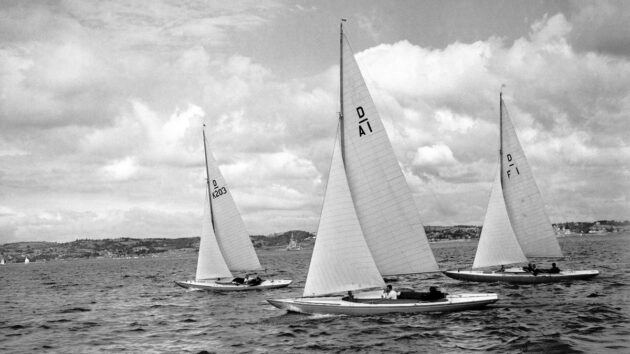
London Olympic Games 1948 regatta in Torbay. Credit: PA Images/Alamy
Greater accessibility
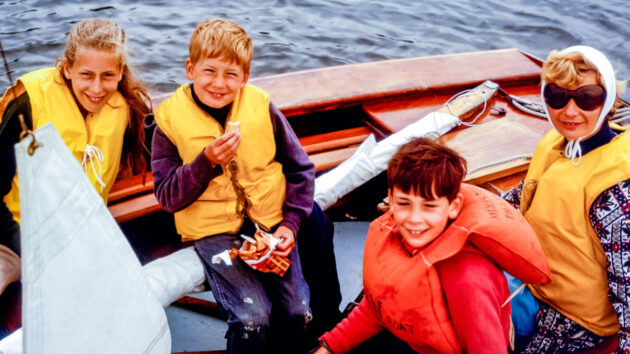
The ‘golden era of boating’, when families took to the water for recreation, prompted the YRA to be renamed the Royal Yachting Association in 1952. Credit: Sally Anderson Archive Photos/Alamy
Concerned that ‘restricted development’ dinghies were making small boat sailing too costly, the YRA instigated a design competition for a National 12ft One Design dinghy, which Uffa Fox won.
This was now being hot-moulded by Fairey Marine at Hamble.
Crucially, the Fairey Firefly was only sold as a package, complete with spars, sails and fittings.
Some 24 Firefly dinghies were pressed into service as the Olympic single-hander.
After the regatta, the Fireflys were sold off ‘as seen’, with several going to schools and colleges.
The growing successes of the Firefly, National 12 and International 14 would help steer the YRA towards one of its most important legacies – leading the drive for inland reservoirs and lakes to be opened up for leisure sailing.
As life carried on after the war years, the early 1950s saw a ‘golden era’ of leisure boating. The growing range of small coastal cruisers meant a whole family could take to the water together, not necessarily racing.
To reflect this new accessibility, in 1952, the YRA became the Royal Yachting Association (RYA). Jack Holt-designed Enterprise and Solo dinghies were seen in increasing numbers at new inland sailing clubs.
With participation at all levels booming, the proliferation of new boat classes led the Royal Yachting Association to take on the Langstone Handicap system, now the Portsmouth Yardstick.
In the 1960s, the Fireball appeared, while the popular classes kept Royal Yachting Association staff busy, processing hundreds of new registrations every year.
Airlines and modern communications were shrinking the world, allowing the UK to bask in Olympic glory with a silver medal for Keith Musto and Tony Morgan at Enoshima for the 1964 Tokyo Games and Acapulco gold for Rodney Pattisson and Iain MacDonald-Smith at the 1968 Mexico City Games.
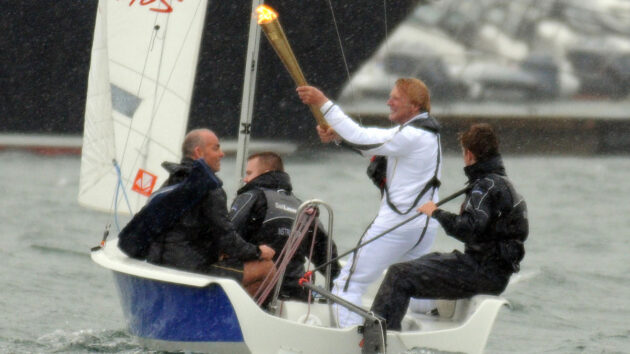
Rodney Stuart Pattisson MBE, carried the London 2012 flame across Portland Harbour in a dinghy. He won double Olympic gold medals in sailing at the 1968 and 1972 Games, followed by Olympic silver at the 1976 Games. Credit: Dorset Media Service
Training ‘gold standard’
The association began its dinghy and coaching training schemes in 1970, and RYA Magazine was launched.
This was also the high-water mark for trailer-sailers competing in open meetings and in 1971, the Royal Yachting Association undertook a major reorganisation that divided it into regions.
The Royal Yachting Association also launched Weymouth Speed Week in recognition of an ever-growing fringe activity – windsurfing.
The yacht cruising community was growing rapidly, as more and more marinas were constructed.
The Board of Trade yacht training scheme was taken under the RYA’s ‘Yachtmaster Scheme’.
This would become the gold standard for this area of training and assessment.
By the mid-1970s, a small one-design Laser dinghy from North America was feeding into the UK’s club structure and sweeping away many established classes.
A boom in windsurfing added to the migration away from organised events.
In a forward-thinking move, the Royal Yachting Association appointed Jim Saltonstall as the National Yacht Racing Coach, bringing a new disciplined approach to sailing.
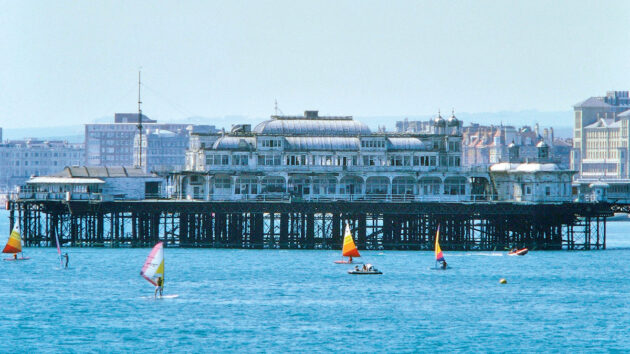
By the 1980s, windsurfing was a popular sport worldwide, here at West Pier, Brighton. Credit: parkerphotography/Alamy
Leisure boating boost
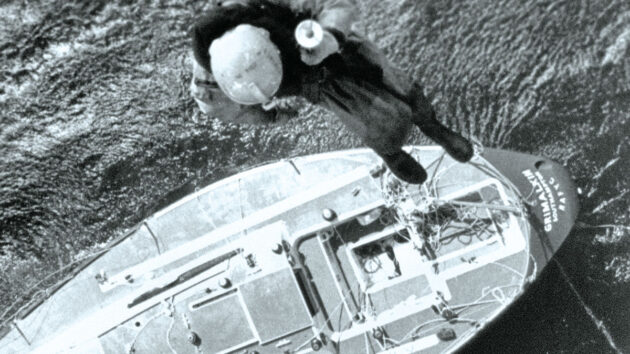
The Royal Yachting Association handled the media during the 1979 Fastnet tragedy and the subsequent inquiry. Credit: PA Images/Alamy
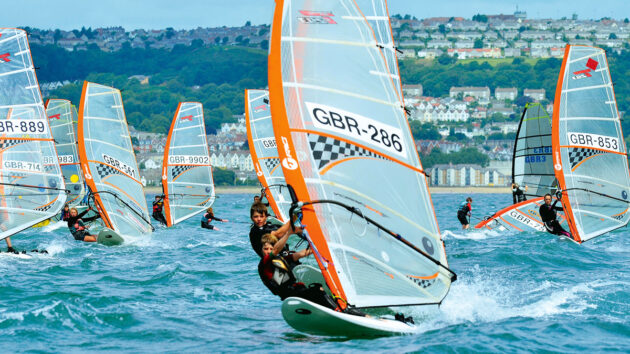
Ex-Royal Navy sailing coach Jim Saltonstall brought a disciplined approach to sail training. Credit: Holden Travel/Alamy
In 1979, when the Fastnet Race fleet was hit by a storm in the Irish Sea, with 15 lives lost and 23 boats abandoned, prompting the largest peacetime maritime rescue in UK waters, the RYA dealt with the media interest and the inquiry that followed.
A few years later, the RYA found itself in the firing line when the association joined other nations in boycotting the 1980 Olympics in response to Russia’s military intervention in Afghanistan, leaving a strong team with medal prospects very disappointed.
More positively, in 1982, windsurfing, the world’s fastest-growing sport at that time, became administered by the RYA.
The following year, the RYA demonstrated its good commercial sense by taking on the organisation of the London Dinghy Exhibition, the biggest dinghy and multihull focused event in the world..
The RYA Motor Cruiser Scheme launched at a time when marina growth offered ‘turnkey’ access to the water, but with little competence checking.
The approach of building on education rather than licensing would set a foundation for safer boating.
The RYA also took over training and accreditation of the marine VHF system, an essential development as low-cost radio sets, fixed and handheld, flooded onto the market.
In the early 1990s, Racing Sailboats began producing single manufacturer one design dinghies that would become cornerstones of the RYA programme.
After a disappointing 1996 Atlanta Olympics for Team GB, with just one gold from rowers Matthew Pinsent and Steve Redgrave, Andy Cassell won gold when sailing made its Paralympic debut. Saltonstall’s training foundations led to a golden era of Olympic performances.
From 1997, National Lottery funding also revolutionised British racing, fuelling future icons such as Shirley Robertson, Ben Ainslie, Iain Percy, Andrew Simpson, Nick Dempsey, Sarah Ayton, Bryony Shaw, Paul Goodison, Helena Lucas, Alexandra Rickham, Niki Birrell and Hannah Mills.
Sir Robin Knox-Johnston told PBO he was on the Lottery panel “and persuasive” when it gave Cassell a 65% grant towards his Sonar boat.
He said: “Jim Saltonstall was the trainer for the UK Olympic success and never gets enough credit.”
Legacy initiatives
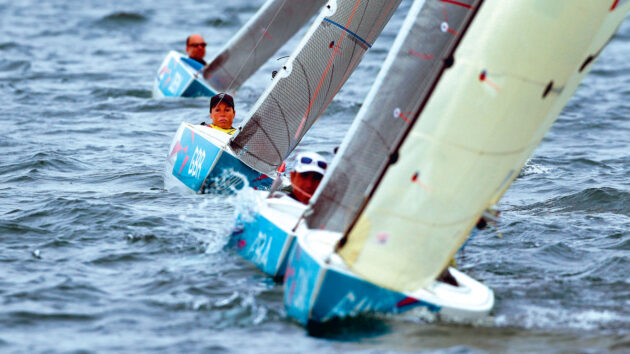
Helena Lucas’s win in the 2.4mR-class at London 2012 was Britain’s first female Paralympic sailing gold – sailing has since been dropped from the Paralympic sports line-up. Credit: David Jones/PA/Alamy
As the new millennium approached, under the ‘Sailability’ banner, the RYA opened up all water-based activities to people with disabilities – perfect timing as sailing was about to become a Paralympic sport.
Para World sailing manager Hannah Stodel, a four-time Paralympian who achieved World Championship success in the Sonar keelboat class with John Robertson and Stephen Thomas and missed out on London 2012 bronze by the cruellest of margins, told PBO: “The RYA has been a cornerstone in my sailing journey – from my early days on the water to competing in the Paralympics to racing offshore and now campaigning for the reinstatement of sailing back to the Paralympics.
“Their support has helped me grow not only as an athlete but also as a coach and advocate for inclusivity in our sport.
“Through dinghy sailing, keelboat sailing, offshore sailing, coaching pathways, and now in my role at World Sailing, I’ve seen firsthand how the RYA’s commitment to accessibility and development continues to shape lives and open doors.
“Their work laid the foundation for so much of what I do today, and I’m proud to be part of a community that’s pushing for a more inclusive future in sailing.”
In 2000, the Sydney Olympic Regatta saw Team GBR take three gold and two silver medals.
The dominating skiff scene was now enticing younger sailors.
In 2004, the RYA launched Onboard, a programme to encourage youth participation.
In 2005, the RYA joined forces with British Marine to form The Green Blue, an initiative to clarify the problems faced, inland and at sea, and to promote best practice among boaters, businesses and clubs on topics such as invasive species, antifouling, anchoring and mooring.
There were celebrations in 2005, when the International Olympic Committee announced London as host city for the 2012 Olympic Games, with Weymouth and Portland as the regatta venue.
The broad base of the RYA would become invaluable for the Games organisation as volunteers filled race management teams and jobs ashore.
The home Olympic regatta was a huge success, with a five-medal haul, and the legacy of an enhanced National Sailing Academy at Portland.
The International Moth boat class was also making Portland Harbour its home.
The foiling Moths inspired the RYA to integrate this high-speed development into traditional forms of dinghy events.
Unexpected challenges
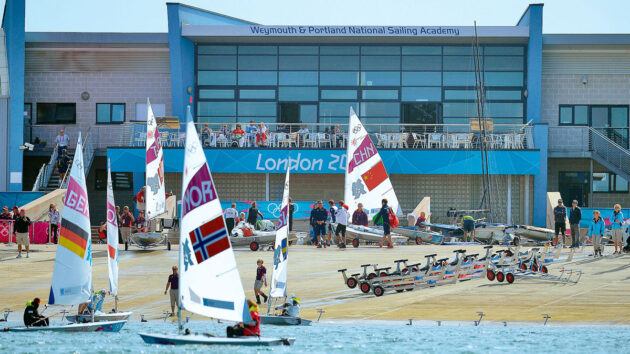
The National Sailing Academy was boosted by the 2012 Olympic events. Credit: Dorset Media Service/Alamy
After the UK voted to leave the European Union in 2016, British sailors’ open access to European waters and freedom of movement of boats and people were suddenly subject to a wide-reaching process of renegotiation.
The Royal Yachting Association worked to soften many of the potential issues and to simplify the new process for crossing the Channel or North Sea with guides for UK-flagged pleasure vessels.
The Covid lockdowns of March 2020 challenged the RYA to manage its own workforce’s needs and provide guidance to the wider boating community.
In 2020 the RYA Diversity Strategy reaffirmed its commitment to equality in all forms of boating.
In 2021, the old Dinghy Show became the Dinghy and Watersports Show, now held at Farnborough International, and the RYA launched a new Wing Training scheme to embrace wing-surfing and wing-foiling.
This followed up on its Kite4Gold talent scheme of 2018 and this early investment into new sailing formats was rewarded with gold at the Paris 2024 Games for Ellie Aldridge in the first Formula Kite event.
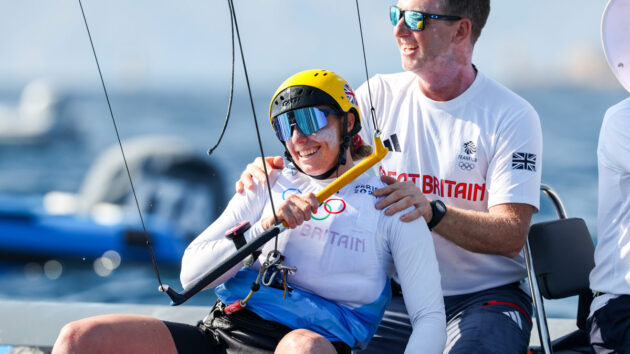
Ellie Aldridge and coach Stevie Morrison, a Double 49er Olympian and past world champion, at the Paris 2024 Olympic sailing regatta in Marseille, France in August, 2024. Credit: World Sailing/Lloyd Images
The RYA today
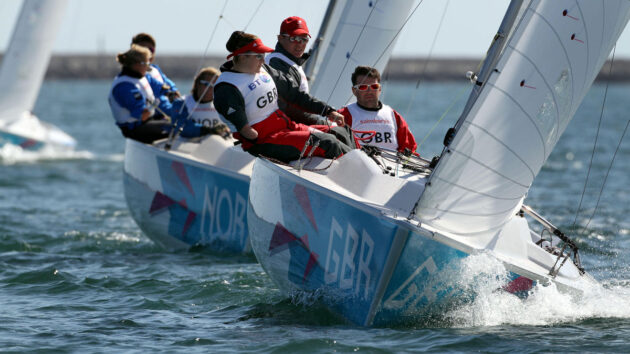
‘The RYA shapes lives and opens doors’ says sailor Hannah Stodel, racing here in the Sonar with John Robertson and Stephen Thomas. Credit: PA Images/Alamy
The Royal Yachting Association now has 100,000-plus members paying annual fees ranging from £19 for under 19s to £90 for families. It employs around 226 staff and supports 25,000-plus RYA-qualified instructors at over 2,400 recognised training centres in 58 countries, where 270,000-plus people take courses each year. It also inspires many volunteers at affiliated clubs and centres, which it celebrates with awards.
Mel Hide, RYA director of external affairs, told PBO: “This anniversary year is a real milestone, celebrating both our proud heritage and our ongoing commitment to boating.
“For almost 150 years, the RYA has been at the heart of the UK’s boating community, shaping the way people get afloat and protecting their right to enjoy the water.
“Founded in 1875 as the Yacht Racing Association, sailing in those early days was a privilege reserved for royalty and the wealthy but over time, the RYA opened the doors to broaden participation.
“The RYA Training Scheme launched in 1970 and continues to provide boaters with a clear pathway to progress, from first time afloat to becoming a Yachtmaster.
“As the RYA evolved it has represented boaters’ voices on a broad spectrum of wider maritime issues – vital work we continue to prioritise today.
“Over many decades we’ve worked to shape the regulatory landscape, enabling boaters to venture overseas through affordable boat registration and evidence of competence.
“We’ve ensured the vast array of domestic legislation is proportionate and helped boaters to understand it — protecting access and navigating the challenges of the UK joining the single market, Brexit, and everything in between.
“Without the RYA’s advocacy, leisure boating in the UK would almost certainly be more expensive, more restricted, and far more heavily regulated.
“As well as looking back, this anniversary also provides us with the chance to look ahead as we continue to champion safe and responsible boating and protect the freedoms of our boaters for generations to come.”
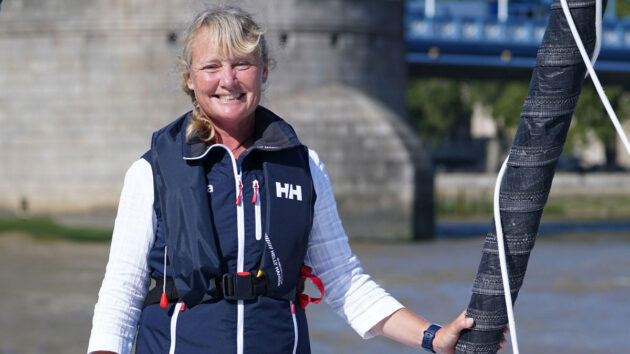
“I am who I am because of the RYA” says offshore solo sailor Pip Hare: Credit: PA Images/Alamy
Vendée Globe round-the-world yachtswoman Pip Hare told PBO: “I am who I am because of the RYA.
“I think it’s really important to think about what the RYA do for non-sailors, as well as sailors, and introducing people to the sport.
“Sometimes we can be really focused on dinghies and the Olympic programme but actually one of the greatest things that they’ve done is the RYA Cruising scheme and opening up a formal route into sailing that is accessible by absolutely everyone.
“And for me, I didn’t grow up in a traditional sailing background. I wanted to get into sailing when I was a teenager and there was a route that I could follow.
“I just went and did my courses, there were exams to take, the exams told people I was qualified and enabled me to get a job and that’s how I started my career.
“And I’ve made a career based on the Cruising scheme and that route.
“Throughout my career I’ve always really heavily supported the sail training side of the RYA, because I feel like it kind of gets overshadowed sometimes by the Olympic pathway programmes.
“I’ve been a jobbing Yachtmaster, I’ve been an RYA cruising instructor, a Yachtmaster instructor, a cruising instructor trainer, a Yachtmaster examiner, I’ve taught theory, I’ve taught sea survival.
“There’s so many different skills and things to learn and it’s those things that give everyday normal people the confidence to go out and become sailors and I very much think that is something the RYA has always done well and continues to do well.
“If anybody asks me ‘How do I get into sailing’, I always say ‘Take a course’ because you can take courses anywhere, you can take courses at night school, at inland yacht clubs, at sailing schools and it gives you skills, confidence to go and be the sailor that you want to be.”
View of Olympic Champions
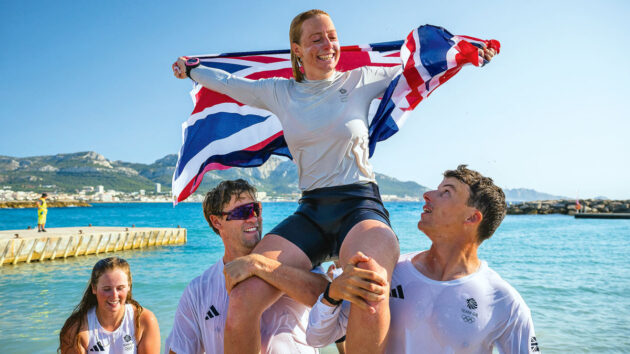
From no women members or small craft to a champion female kite surfer. Credit: World Sailing/Jean-Louis Carli
Ellie Aldridge, from Poole, Dorset, first took the tiller aged five, when her family bought a wooden sailing dinghy called AB.
Her family were members of Parkstone Yacht Club, an RYA training centre.
Aldridge said: “Going out sailing with your friends gives you a freedom that is totally different to normal life.”
After leaving school in 2016, she raced the 49erFX skiff with Megan Brickwood before taking a gamble in 2018 to switch to the new RYA Kite4Gold scheme.
She said: “It was daunting to give up something you’ve been working on for quite a long time, with someone you’re good friends with, to step back and learn something completely new.
“But the opportunity of a new class to pioneer and a new generation of people was really exciting.”
Aldridge loved the supportive team of young women who all started at the same time, and the adrenaline of racing at 30 knots, navigating under pressure in a craft “the size of an ironing board.”
Within a year, she was European Champion, then a regular on the World Championship podium before securing a Team GB slot.
Last year, Aldridge claimed the inaugural women’s kite Olympic crown at Paris 2024.
The 28-year-old said: “The RYA has given me the best platform over the past 10 years to learn so much from the depth of talented sailors, coaches and support staff of the British Sailing Team (BST), without whom I would not be where I am today.”

The new foiling classes ‘mean more change than ever and no less challenge’ for the RYA and the British Sailing Team – says ILCA sailor Micky Beckett. Credit: Jacob King/PA Images/Alamy
Aldridge’s fiancé Micky Beckett, an ILCA (Laser) dinghy – sailor who narrowly missed out on bronze at the Paris 2024 Games, learned to sail in a home‑built dinghy made by his boatbuilder Dad in Pembrokeshire, Wales.
Beckett, 30, told PBO: “I’ve been part of RYA squads and a wider ‘system’ for over 20 years, during which time I’ve progressed from my RYA qualifications all the way to the Olympics.
“The challenge the Team and the RYA always have is creating a pathway that can suit and support sailors from an incredibly wide range of backgrounds, that isn’t so restrictive that it fails to accommodate the individual that we all are when competing at our very best.
“The perception of the BST from other parts of the sailing world is unfortunately quite wide of the mark – something where I believe there is room for improvement – to better explain what exactly ‘full-time Olympic campaigning’ is.
“It’s not filling out food diaries and living a life planned by an expert, it’s a very high degree of autonomy with the independence and freedom to figure it out myself.
“I can draw on the best expertise but ultimately nobody can do my training for me, so I’m educated but never told how to do it, and nobody tells me what to eat!
“With the advent of new foiling classes and the likely reincarnation of Olympic race formats, there is more change than ever and no less challenge for the RYA and the BST.
“The competition from other countries has largely caught up on the easier areas that we first pioneered, so to keep winning medals we have to be willing to be creative and no less determined than ever.”
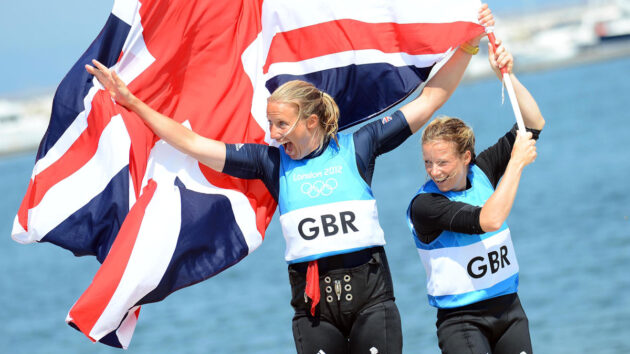
Saskia Clark and Hannah Mills claimed silver at the London 2012 Games and went on to win gold in Rio 2016. Credit: Dorset Media Service/Alamy
The world’s most successful female Olympic sailor Hannah Mills, who achieved London 2012 silver and Rio 2016 gold with Saskia Clark in the 470 dinghy class, then Tokyo 2020 gold with with Eilidh McIntyre, told PBO: “The RYA has been one of the key organisations that nurtured my passion and enabled the start of my sailing career, supporting my journey from grassroots at my local club in Wales right through to elite competition and representing my country at the Olympic Games.
“The RYA’s 150-year legacy is the sailors and communities it has inspired and empowered.
“They do a brilliant job catering for all levels and interests, whether that’s racers, cruisers, motorboaters or yacht owners, always ensuring safe regulations, fair access, and continued opportunities in the sport we all love”.
RYA Sailability is a success story
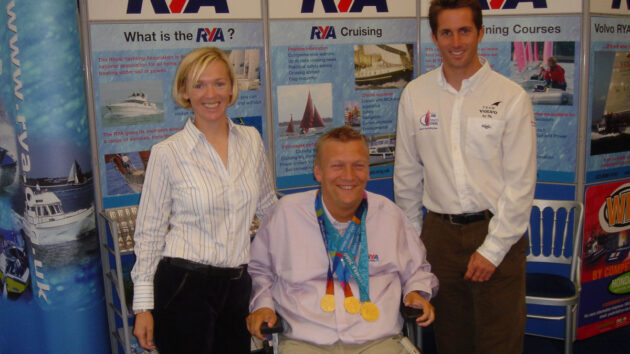
Geoff Holt MBE, pictured here with Shirley Robertson, OBE, and Ben Ainslie, OBE, is proud to have been part of the RYA Sailability history
Round-Britain yachtsman and quadriplegic adventurer Geoff Holt, WetWheels charity founder, was elected to the Royal Yachting Association Council in 1992 to represent UK disabled sailing.
He said: “It was clear then that the RYA was committed to inclusivity and diversity within our sport.
“I continued to sit on the Council for another 12 years before becoming one of the first directors of the Royal Yachting Association Board.
“From campaigning for the inclusion of sailing as a Paralympic sport (leading to inclusion in the 1996 Atlanta games as a demonstration sport), to the development of disabled sailing through the RYA Sailability network, now extending to more than 200-plus groups around the UK, the RYA has been at the forefront of disabled sailing – not only in the UK, but internationally where we are respected as one of the most progressive nations in the world.
“I am very proud to have played a small part in that process, including Chairing RYA Sailability for a number of years after forming the organisation in 1995.
“We have come a long way, there are still work to do, but there is no organisation anywhere in the world better placed than the RYA to understand what those challenges are and how to overcome them.”
Special podcast
Tune in to a special edition podcast series celebrating the people, places and moments that have defined boating over the last century and a half.
The RYA series is due to go live on 23 September to mark its 150th anniversary at: www.rya.org.uk/about-us/150-years/150-podcast
Want to read more articles like ‘What’s the Royal Yachting Association done for British boating’?
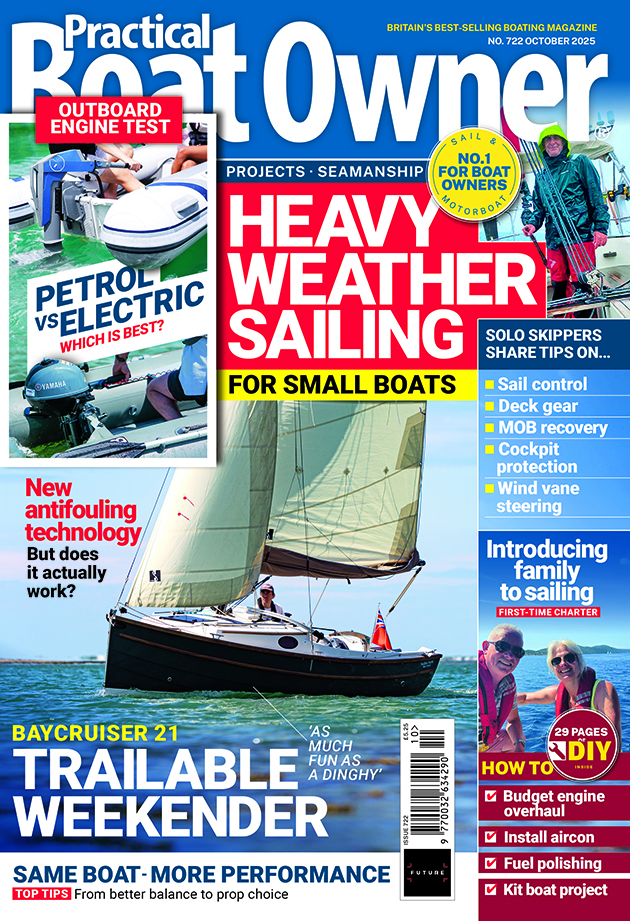
A subscription to Practical Boat Owner magazine costs around 40% less than the cover price.
Print and digital editions are available through Magazines Direct – where you can also find the latest deals.
PBO is packed with information to help you get the most from boat ownership – whether sail or power.
-
-
-
- Take your DIY skills to the next level with trusted advice on boat maintenance and repairs
- Impartial, in-depth gear reviews
- Practical cruising tips for making the most of your time afloat
-
-
Follow us on Facebook, Instagram, TikTok and Twitter

